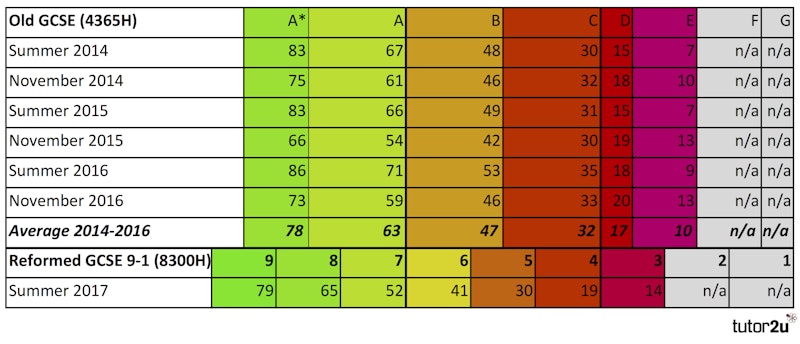In the News
2017 GCSE Maths Grade Boundaries (AQA)
24th August 2017
Results are in. How do the new grade boundaries compare with the old ones? Here are the grade boundaries (as percentages) for AQA alongside those for 2014-2016:


The grade boundaries are lower as was to be expected under the new tougher examinations. The pass grade 4 (equivalent to the old grade C) is 19% on the higher tier and 52% on the foundation tier. Both are down on previous years. The average for a grade C during the years 2014-2016 was 32% for higher and 60% for foundation.
For this year's exams, the exam boards agreed that a grade 7 was equivalent to the old grade A. The grade boundary for a 7 this year is 52%. Previously for a grade A you needed around 63% (average for 2014-2016). So, comparing old with new as far as the benchmark grade A (now grade 7), students needed 11% less than they would have done previously.
At the higher end of the spectrum, if you compare the grade boundary for the previous top grade A* with the new top grade 9, there's little difference. For grade 9 this year, you needed 79%. The average grade A* boundary over the last three years was 78%. Given the significantly more difficult nature of the exam this year, students have had to work harder to achieve grade 9. This is what was intended by the reforms. For grade 8, students needed 65%. This is a little over what was previously needed for a grade A (grade A average was 63% for 2014-2016). A grade 8 is a very solid grade!
One thing that did stand out when looking at these grade boundaries is how the AQA and Edexcel boundaries compare. They are so similar, and the top grades (7, 8 and 9) are identical. This implies that AQA's examinations were no more or less difficult than Edexcel for these top grade students.

You might also like
Don’t Let Down The GCSE Class of 2017
19th July 2017
2017 GCSE Maths Grade Boundaries (Edexcel)
24th August 2017
North Korea's Sixth Nuclear Test
4th September 2017